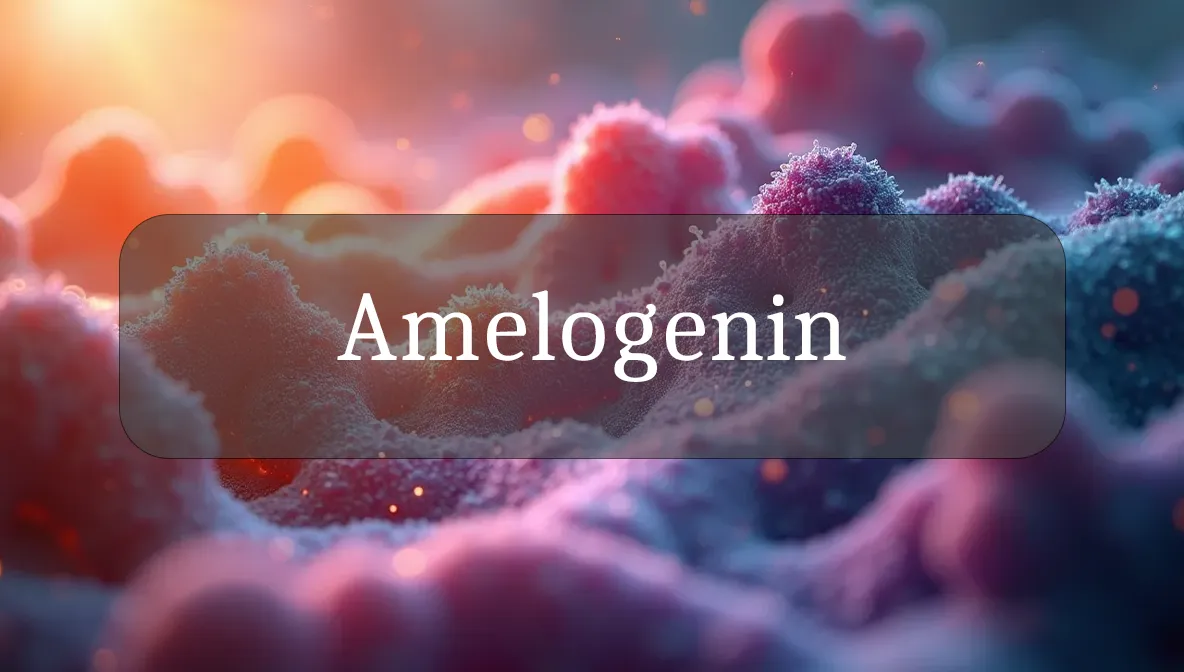Protein That Builds Strong Tooth Enamel
Amelogenin is like your teeth’s master builder, a protein that shapes and strengthens tooth enamel, the hardest substance in your body. It’s a key player in oral health and daily wellness, ensuring your teeth are tough enough to handle chewing and smiling with confidence. Let’s explore what amelogenin is, how it benefits your health, and its fascinating role—all in a clear, friendly way to empower your wellness journey.
Chemical Identity and Type
Amelogenin is a hydrophobic phosphoprotein, a small extracellular matrix protein (5–45 kDa) rich in amino acids like proline, leucine, histidine, and glutamine. It’s produced by the AMELX gene on the X chromosome and the AMELY gene on the Y chromosome in males, with multiple isoforms created through alternative splicing or proteolysis. Amelogenin contains a single phosphorylated serine at position 16 and forms unique nanosphere structures that guide enamel formation. It’s synthesized by ameloblast cells in developing teeth, not consumed directly from food.
Biological Role and Benefits
Amelogenin is your teeth’s architect, orchestrating the formation of enamel during amelogenesis. Here’s how it supports your wellness:
- Enamel Formation: Amelogenin directs the growth and organization of hydroxyapatite crystals, creating a highly organized enamel matrix of rods and interrod crystals for strong, durable teeth.
- Tooth Strength: It ensures enamel’s hardness (like rock) and resistance to wear, protecting teeth during chewing and preventing decay.
- Dental Health: By forming a robust enamel layer, amelogenin supports lifelong oral health, reducing cavity risk and maintaining a confident smile.
- Tissue Regeneration (Emerging Role): Recent research suggests amelogenin may recruit mesenchymal stem cells, aiding periodontal tissue repair and bone regeneration.
- Evolutionary Conservation: Amelogenin’s presence in vertebrates (mammals, reptiles, amphibians) highlights its critical role in tooth development across species.
By building strong enamel, amelogenin enhances your oral health, chewing ability, and overall well-being.
Dietary or Natural Sources
Your body produces amelogenin during tooth development, relying on amino acids and nutrients from your diet. Key sources to support enamel health and related processes include:
- Protein-Rich Foods: Eggs, chicken, fish (salmon, tuna), and lentils (provide proline, leucine, and other amino acids for protein synthesis).
- Calcium-Rich Foods: Dairy (milk, cheese), leafy greens (kale), and fortified foods (support hydroxyapatite formation in enamel).
- Phosphorus-Rich Foods: Nuts, seeds, fish, and whole grains (essential for enamel mineralization).
- Nutrient Boosters: Vitamin D (egg yolks, fortified dairy), vitamin C (oranges, bell peppers), magnesium (spinach, almonds), and zinc (oysters, seeds) promote dental and bone health.
- Hydration: Water (8–10 cups daily) supports saliva production, which protects enamel.
No amelogenin supplements exist, as it’s made in the body during tooth development. Calcium (1,000–1,200 mg daily) or vitamin D (1,000–2,000 IU daily) supplements may support enamel health, but consult a doctor first. Aim for 0.8–1.2 grams of protein per kilogram of body weight daily (e.g., 56–84 grams for a 150-pound person).
Signs of Imbalance or Dysfunction
Amelogenin dysfunction, often from genetic mutations or developmental issues, can affect enamel formation. Signs include:
- Amelogenesis Imperfecta (AI):
- Thin, soft, or discolored enamel (yellow, brown, or chalky).
- Brittle or pitted teeth prone to breaking or cavities.
- Sensitivity to hot or cold foods.
- Tooth Weakness: Poor enamel structure leading to rapid wear or dental issues.
- Periodontal Issues (Emerging): Impaired amelogenin function may limit tissue regeneration, affecting gum or bone health.
These issues are often linked to mutations in the AMELX or AMELY genes, stress during tooth development, or nutritional deficiencies. Amelogenin overproduction is not typically a concern, as it’s degraded after enamel formation.
Supporting Optimal Function
Since amelogenin is active during tooth development (before teeth erupt), focus on supporting enamel health and oral wellness:
- Eat a Tooth-Friendly Diet: Include calcium (dairy, greens), phosphorus (fish, nuts), and protein (eggs, lentils) to support enamel and dental health.
- Boost Key Nutrients: Consume vitamin D (salmon, fortified milk), vitamin C (berries, peppers), and magnesium (nuts, spinach) for strong teeth and gums.
- Practice Oral Hygiene: Brush twice daily with fluoride toothpaste, floss, and visit a dentist regularly to protect enamel.
- Avoid Acidic Foods/Drinks: Limit soda, citrus, or sugary snacks to prevent enamel erosion.
- Stay Hydrated: Drink water to maintain saliva flow, which neutralizes acids and protects enamel.
- Limit Stress: Chronic stress during childhood may affect tooth development; promote a healthy environment for kids.
- Consider Supplements: Calcium (1,000–1,200 mg daily) or vitamin D (1,000–2,000 IU daily) may support dental health, but consult a doctor.
Safety, Interactions, and Precautions
Amelogenin is naturally produced during tooth development and safe when functioning properly. Consider these points:
- Genetic Conditions: Mutations in AMELX/AMELY genes can cause amelogenesis imperfecta, requiring dental care or genetic counseling.
- Nutritional Deficiencies: Lack of calcium, vitamin D, or protein during childhood can impair enamel formation; ensure a balanced diet for kids.
- Dental Health Risks: Poor oral hygiene or acidic diets can damage enamel, negating amelogenin’s benefits; prioritize dental care.
- Supplements: Calcium or vitamin D are safe but may cause digestive upset in high doses (e.g., above 2,500 mg for calcium).
- Allergies: Dairy-based calcium supplements may trigger reactions in sensitive individuals.
Focus on a nutrient-rich diet and oral hygiene to support enamel health long-term.
Fun Fact
Did you know amelogenin is so unique it’s used in forensic science to determine sex? The AMELX and AMELY genes differ slightly, allowing scientists to identify male or female DNA from teeth, even in ancient remains
Citations
- National Institutes of Health. (2023). Amelogenin and enamel formation. MedlinePlus.
- ScienceDirect. (2023). Amelogenin: Structure and function in enamel development.
- PMC. (2023). Amelogenin in dental and periodontal regeneration.
- PLOS Biology. (2009). Amelogenin’s role in enamel prism organization.
- World Health Organization. (2020). Nutrition for oral health.

